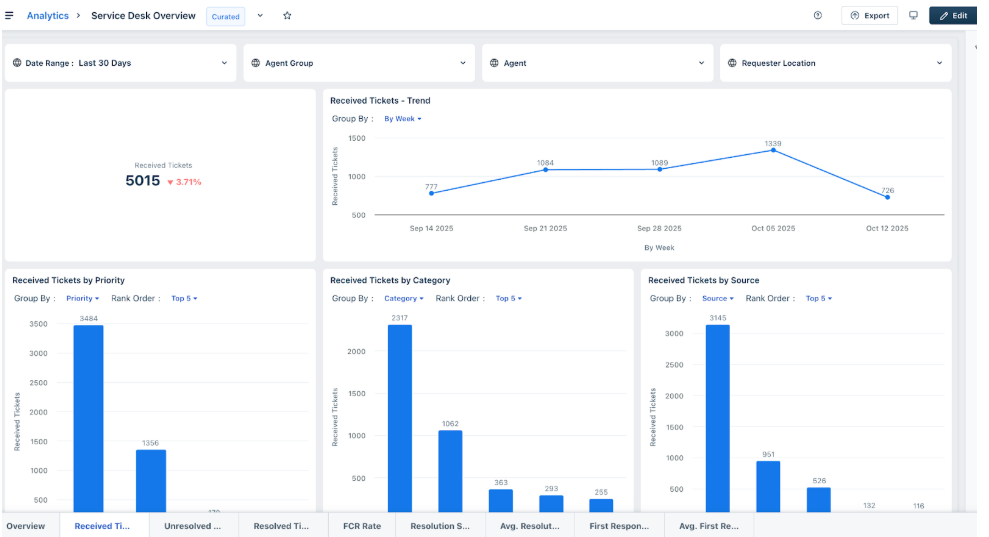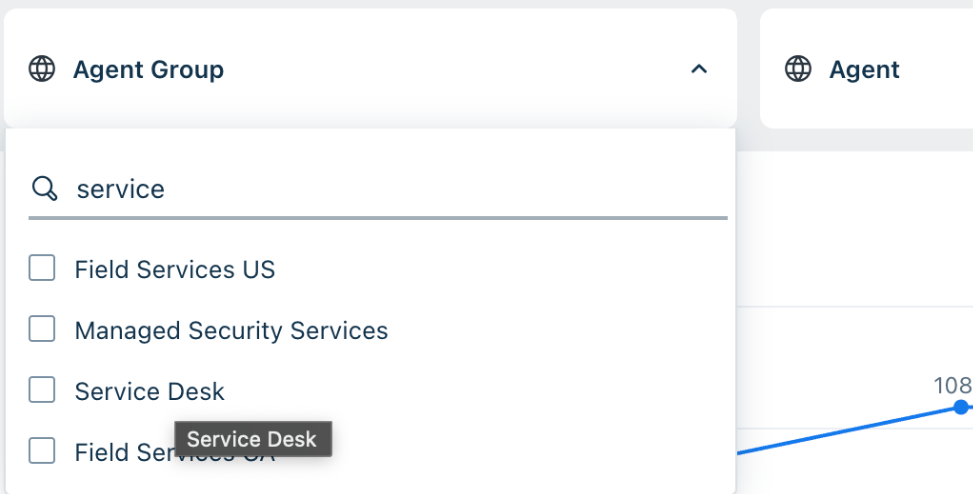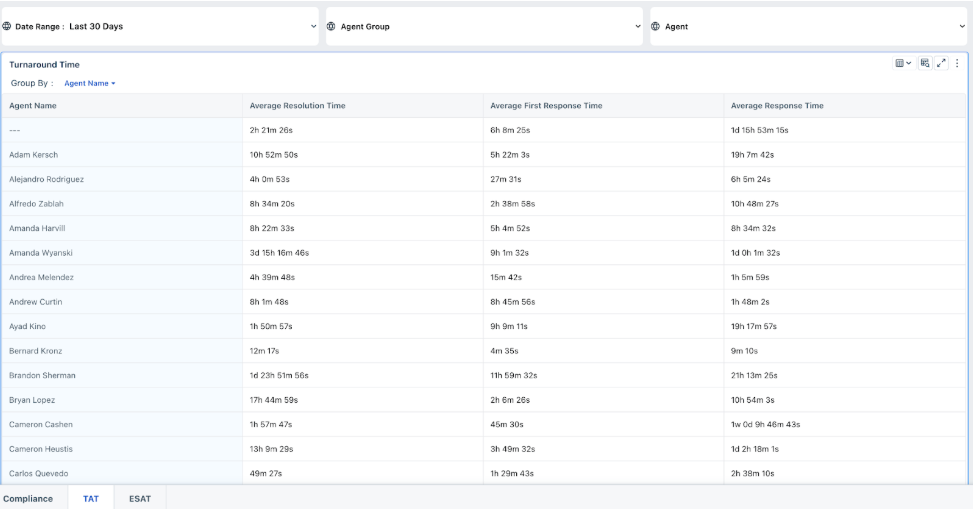This guide outlines best practices for assigning Freddy AI Copilot licenses to IT agents, leveraging analytics to optimize license allocation and improve operational efficiency.
TABLE OF CONTENTS
- Overview
- 1. Identify Agents with High Incoming Ticket Volume
- 2. Identify Agents with low TAT (Turn Around Time)
- 3. Agents Handling Complex Tickets
- License Assignment Strategy
- Conclusion
Overview
Freddy AI Copilot is a powerful tool that can significantly enhance agent productivity and customer satisfaction. By strategically assigning licenses based on performance data, you can maximize their impact and ensure that the right agents receive the support they need.
License Assignment Checklist
- Identify agents with above-average ticket volumes
- Review TAT and SLA compliance from Agent Performance dashboard
- Assign licenses to agents who meet high-volume or low-TAT thresholds
- Ensure Freddy Copilot is enabled in admin settings
Leveraging Analytics for License Assignment
Analytics plays a crucial role in identifying the agents who would benefit most from Freddy AI Copilot. We will focus on the following key metrics to inform our decisions:
1. Identify Agents with High Incoming Ticket Volume
Agents in this category are likely overwhelmed and struggling with a high volume of tickets. Freddy AI Copilot can provide invaluable assistance by automating routine tasks, suggesting responses, thereby helping these agents improve their compliance and efficiency.
Step 1: Access Analytics
- Navigate to Analytics in your Freshservice dashboard.
- Under Curated Reports, open the report named “Service Desk Overview.”

Step 2: Open the Received Tickets Report
- Within the Service Desk Overview, go to the “Received Tickets” tab.
- This report shows the number of tickets handled by each agent — a key metric for license assignment.

Step 3: Filter by Agent Groups (L0 & L1 Teams)
- Click on the Agent Group filter.
- Select your Level 0 (L0) and Level 1 (L1) support teams — e.g., Service Desk, IT Support Level 1, Health Desk, etc.
- Click Apply to filter results.

Step 4: Customize the Report
- Locate the “Received Tickets Category” report and expand the report.
- Click Edit and change the Group By setting from Category to Agent Name.
- Click Apply.

Step 5: Identify High-Volume Agents
- Review the report to see the number of tickets received per agent.
- Calculate or note the mean (average) ticket volume.
- Agents above the mean are ideal candidates for Freddy AI Copilot license assignment.

Step 6: Finalize the List
- Based on your analysis, select the top-performing agents .
- Proceed with assigning Copilot licenses to these agents.
2. Identify Agents with low TAT (Turn Around Time)
These high-performing agents can be further elevated with Freddy Copilot by offloading repetitive tasks, giving them the bandwidth to mentor peers, handle escalations, or take on complex issues.
Step 1: Access the Agent Performance Report
- Navigate to Analytics → Curated Reports.
- Open the Agent Performance Report → Go to the TAT tab.

Step 2: Set the Date Range
Adjust the date range to cover the last 3 months for better performance insights.

Step 3: Filter by Agent Group
- Click on Agent Group.
- Select your L0 and L1 teams (e.g., Service Desk, IT Support Level 1).
- Click Apply.
Step 4: Analyze Key Metrics
Review metrics for each agent:
- Average Resolution Time
- Average First Response Time
- Average Response Time
- Identify agents with the highest averages (i.e., slower responders).
Step 5: Shortlist Agents for Freddy AI Copilot Support
Agents with higher average times are potential candidates for Freddy AI Copilot — they can benefit most from AI assistance to improve productivity and speed.
Step 6: Export and Review
Optionally, export the report to Excel.
Sort the data (highest to lowest) for quick identification of underperforming agents.
3. Agents Handling Complex Tickets
Agents who frequently handle complex tickets require extensive knowledge and often spend more time researching solutions. Freddy AI Copilot can act as an intelligent knowledge base, providing quick access to information, suggesting troubleshooting steps, and even drafting comprehensive responses.
Step 1: Understand What Defines a Complex Ticket
A complex ticket can be identified by:
- High Agent Reply Count
- High Customer Reply Count
- High Public Notes Count
- High Private Notes Count
Agents frequently handling such tickets are likely managing complex and high-effort cases.
Step 2: Access Analytics
- Navigate to Analytics → Curated Reports.
- Clone any existing report (this will allow customization).
- Once cloned, you’ll see it listed under Private Reports.

Step 3: Edit the Cloned Report
- Open the cloned report and click on Edit (top-right corner).
- Select Add Widget → choose Chart.
- Drag and drop the chart widget into your report.
- Click on Agent Group.
- Select your L0 and L1 teams (e.g., Service Desk, IT Support Level 1).
 Step 4: Add Metrics and Grouping
Step 4: Add Metrics and Grouping
Expand the report in the Metrics section, search and add:
- Agent Reply Count
- Customer Reply Count
- Public Notes Count
- Private Notes Count
Under Group By, select Agent Name.

Step 5: Export & Calculate Complexity
- Click on Underlying data and export the data to Excel (XLSX).Sum up:
- Agent Reply Count
- Customer Reply Count
- Public Notes Count
- Private Notes Count
License Assignment Strategy
The following table outlines a suggested strategy for assigning Freddy AI Copilot licenses based on the analytical insights:
| Agent Profile | Freddy AI Copilot Assignment ratio | Rationale |
| High Ticket Volume | 40% | Enhance existing high performance, potentially increasing capacity and efficiency. |
| Low TAT | 30% | Maximize immediate impact on operational efficiency and SLA adherence. |
| Handling Complex Tickets | 30% | Improve resolution times and quality of service for intricate issues. |
Conclusion
By adopting a data-driven approach to Freddy AI Copilot license assignment, we can ensure that this valuable resource is allocated effectively, leading to improved agent performance, higher SLA compliance, and ultimately, enhanced customer satisfaction. This guide serves as a living document and will be updated as we gather more insights and refine our strategies.
